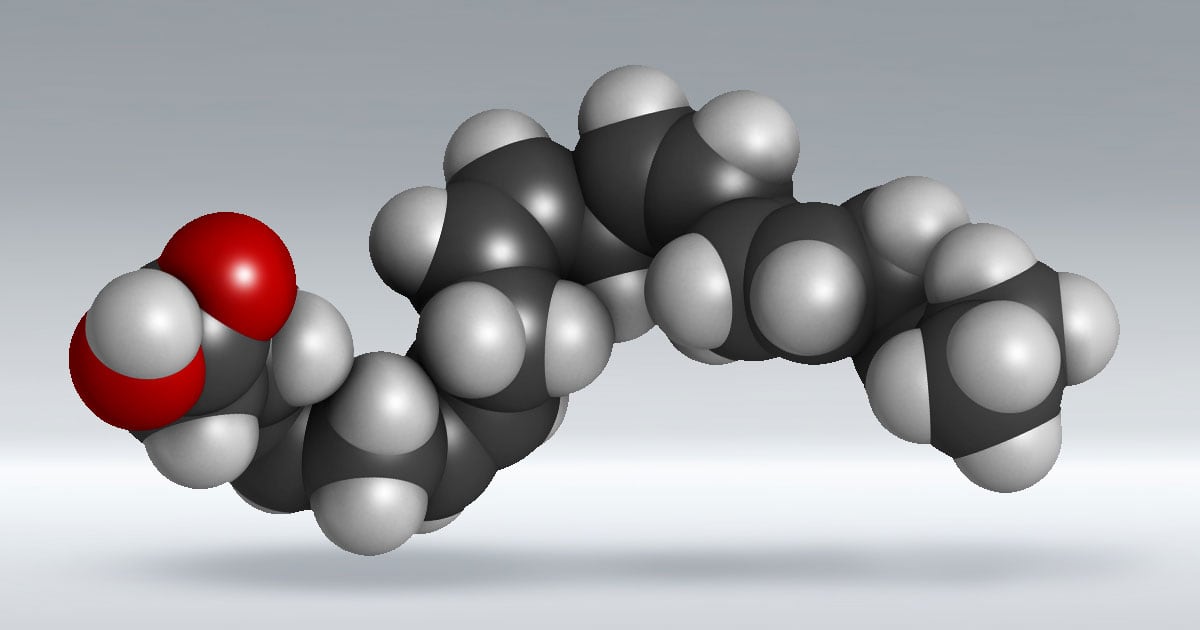Have you ever met a dog with a soft, thick, lustrous coat and immediately asked what brand of food the dog eats? If you have, you’re not alone. Many dog parents judge their dog’s health — and the quality of the dog food they feed — by the condition of their pet’s coat and skin. That makes sense when you consider the prominent visibility of a dog’s coat — and that nothing affects the condition of your pet’s skin and hair more than food.
Essential fatty acids, including key omega-3 and omega-6 fatty acids, play a key role in skin health. What are essential fatty acids? What makes a fatty acid an omega-3 or an omega-6 fatty acid? Which ones, if any, are required? Does dog food provide enough of the right fatty acids? We’ll answer those questions and more to help you understand what your dog needs.
The skinny on dietary fats and fatty acids
Dietary fats are one of six categories of nutrients, the components of food that the body must have to support life. A naturally occurring component of all fats, aka lipids, fatty acids are:
- Key building blocks of cell membranes that provide structure and flexibility
- Precursors of some hormones and chemical signals within and between cells
- Fuel molecules that provide a concentrated source of energy, or calories
- Transporters that enable absorption of fat-soluble vitamins
Nutritionists group fatty acids based on three characteristics:
- The length of the carbon-chain backbone of the fatty acid; that is, short, medium or long
- The degree of saturation, or number of double bonds between carbon atoms in the backbone; for example, saturated, unsaturated (or monounsaturated) and polyunsaturated
- The location of the first double bond within the carbon chain, starting from the methyl, or omega, end of the fatty acid; that is, omega-3, omega-6 and omega-9
(While this chemistry stuff may seem like gobbledygook now, it will start to make sense! And it’s even relevant for your own nutrition and diet.)

Dogs require certain fatty acids
Like amino acids, the building blocks of proteins, some fatty acids are considered essential and others are not, although they will be present in food. Essential fatty acids are those the body can’t make — or can’t make enough of — on its own to meet its requirements. Essential fatty acids must be obtained from food to prevent deficiencies, and can be found in both plant- and animal-based ingredients.
Dogs require long-chain fatty acids from both the omega-6 and omega-3 groups for optimum health. What makes a fatty acid an omega-3 fatty acid is the presence of a double bond between the third and fourth carbon atoms in the carbon-chain backbone. In omega-6 fatty acids, the first double bond occurs between the sixth and seventh carbon atoms. Long-chain omega-6 fatty acids are important for cell membrane structure and integrity, skin health, growth, reproduction and fat transport within the blood. Omega-3 fatty acids are also important for skin health and cell membrane flexibility, and are critical for proper brain and retina (part of the eye) development and function.
Of the omega-6 fatty acids, linoleic acid is considered essential for dogs — and all other animals. Most animals, including dogs, can convert linoleic acid into gamma-linolenic acid and arachidonic acid, two other omega-6 fatty acids needed by the body and found in food. Although linoleic acid is found in sunflower and safflower oils, corn oil is one of the best sources of this essential fatty acid. It is also present in poultry and pork fat.
The essential omega-3 fatty acids for dogs are alpha-linolenic acid (ALA), eicosapentaenoic acid (EPA) and docosahexaenoic acid (DHA). EPA and DHA are found primarily in cold-water fish, including salmon, mackerel, halibut and herring, or oils made from them, and in krill oil and in products made from algae. Flaxseeds and chia seeds are rich in alpha-linolenic acid. Research has shown that dogs, like people, can convert ALA into EPA and DHA in their liver, but the process is not efficient. Fish oils are better sources of EPA and DHA for dogs than plant-based omega-3 fatty acid sources.
Fatty acids play important roles in skin health
Both omega-6 and omega-3 fatty acids help maintain healthy skin. To understand the role of fatty acids in skin, it may be helpful to understand the key functions of your canine companion’s skin.
The three primary functions of skin are protection, regulation and sensation.
Skin’s most important function is to provide a barrier, protecting the internal body from various environmental elements — bacteria, fungi, parasites, ultraviolet light and more. Skin not only keeps out unwanted substances but helps protect against fluid loss and dehydration. Blood vessels and hair help dogs maintain normal body temperature during hot and cold weather. Skin also is where dogs detect sensations such as touch, temperature and pain.
The outermost layer of the epidermis, known as the stratum corneum, consists of flat, keratin-filled dead cells that are held together by water-repelling lipids (fats), much like a brick wall. The “bricks” are the keratin-filled cells and the “mortar” is a lipid matrix of ceramides (a family of naturally occurring waxy lipids found in cell membranes), cholesterol and free fatty acids. It’s this brick-wall-like structure — the epidermal skin barrier — that is responsible for controlling water loss and protecting against environmental allergens and disease-causing microorganisms.
Linoleic acid plays a key role in maintaining a healthy epidermal skin barrier. In the epidermis, linoleic acid is incorporated into specific very-long-chain fatty acids that form the ceramides essential for the epidermal barrier matrix. In addition, linoleic acid is the precursor of arachidonic acid, a major component of cell membranes that contributes to skin’s structural integrity.
Like arachidonic acid, the omega-3 fatty acids EPA and DHA also contribute to healthy skin structure as part of cell membranes. These essential fatty acids compete with arachidonic acid to be converted into biologically active lipids known to play roles in inflammation and immune response. In fact, one of the reasons why EPA and DHA are popular supplements for managing itchy skin conditions such as allergies and atopic dermatitis in dogs is related to the chemical signals produced from EPA and DHA in response to cell damage. When physical or chemical injury to skin occurs, the omega-6 fatty acids in the damaged cell membranes — primarily arachidonic acid — are converted into pro-inflammatory substances (prostaglandins and leukotrienes). If omega-3 fatty acids are present, they are converted into compounds that are less pro-inflammatory and can reduce an allergic condition or inflammation.
Dog foods should provide enough of the correct fatty acids
Deficiencies of essential fatty acids are rare in dogs (and cats) fed complete and balanced diets. As animal and veterinary nutritionists learn more about the nutritional needs of dogs and as more research is done, recommendations for nutrient requirements and dietary nutrient profiles have been updated.
The National Research Council (NRC) and the Association of American Feed Control Officials (AAFCO) recognize that fat and specific fatty acids are essential to a dog’s diet, and have established recommended and/or required levels for pet food. These requirements vary with different life stages.
In 2006, the NRC published its recommended allowances for total fat, linoleic acid, a-linolenic acid, arachidonic acid and the combination of EPA and DHA for puppies and adult dogs. The organization also identified maximum levels for some of these fatty acids. Subsequently, AAFCO nutrient profiles have included minimum requirements for the concentration of crude fat, linoleic acid, ALA and EPA+DHA in dog food. The dog nutrient profiles also include a maximum of 30:1 for the ratio of omega-6 fatty acids to omega-3 fatty acids that, in effect, establishes a minimum level of omega-3 fatty acids, according to David Dzanis, a board-certified veterinary nutritionist and pet food regulatory specialist.
Based on what animal and veterinary nutritionists now know, dogs need a combination of omega-6 and omega-3 fatty acids for optimal health, even though the ideal ratio of the two is still debated. If you want to know how much omega-3 and omega-6 fatty acids are included in your dog’s food, check the guaranteed analysis on the package. For example, Diamond CARE Sensitive Skin Formula for Adult Dogs contains a minimum of 2.5 percent omega-6 fatty acids and a minimum of 0.8 percent omega-3 fatty acids on an as-fed basis. In addition, Diamond Pet Foods offers Diamond Naturals Skin & Coat All Life Stages Dog Salmon & Potato Formula that includes minimum levels of 0.05 percent DHA, 2.5 percent omega-6 fatty acids and 0.4 percent omega-3 fatty acids.
If you have any questions about your dog’s skin and coat, be sure to discuss them with your veterinarian. Early intervention is often the key to providing relief from skin conditions. And the solution may be as simple as changing your dog’s food to a formula designed for dogs with sensitive skin.
RELATED POST: Understanding Your Dog’s Skin and Coat Layer by Layer








